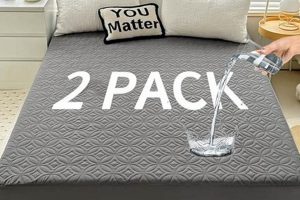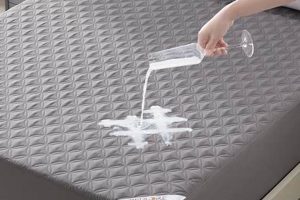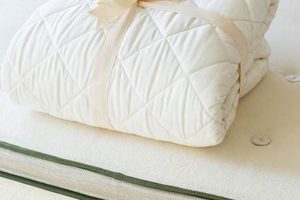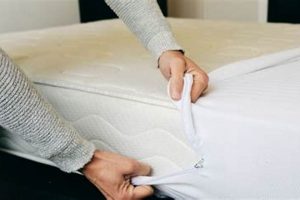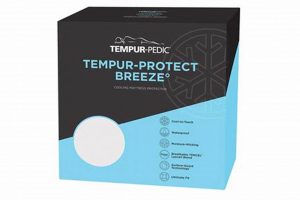A bedding item crafted from materials sourced directly from the environment, designed to shield a mattress from liquids, allergens, and wear. These items typically utilize components such as organic cotton, wool, bamboo, or latex to create a barrier. For instance, a tightly woven covering made of untreated cotton serves to protect the mattress core from dust mites and spills.
The implementation of such a safeguard can extend the lifespan of the mattress, preserving its hygiene and structural integrity. Historically, simpler versions have existed for centuries, utilizing readily available fabrics. Current iterations offer enhanced protection and comfort, aligning with a growing consumer demand for sustainable and non-toxic home products. The utilization of these items mitigates the need for frequent mattress replacement and reduces potential exposure to synthetic materials often found in conventional bedding.
The subsequent sections will explore the specific types of naturally derived materials employed in their construction, delve into the advantages offered over synthetic alternatives, address common concerns regarding their care and maintenance, and provide guidance on selecting a suitable product based on individual needs and preferences.
Guidance on Selecting and Maintaining Bedding Protection
The following provides insights into maximizing the benefits of using coverings designed to protect mattresses composed of environmentally conscious materials. These tips assist in making informed purchasing decisions and ensuring longevity of the chosen product.
Tip 1: Material Selection is Paramount. Opt for organic cotton, wool, bamboo, or natural latex. These materials minimize exposure to harmful chemicals and offer varying degrees of water resistance, breathability, and allergen protection. Verify certifications, such as GOTS or Oeko-Tex, to ensure material authenticity and quality.
Tip 2: Consider Waterproofing Needs. Assess the level of protection required. For young children or individuals prone to spills, a waterproof layer made from a thin, breathable polyurethane (often laminated to natural fibers) may be necessary. Balance waterproof capabilities with breathability to prevent heat buildup.
Tip 3: Evaluate Weave Density. A tightly woven fabric provides enhanced protection against dust mites and allergens. Look for products with a high thread count. A denser weave naturally impedes penetration from small particles.
Tip 4: Prioritize Breathability. Natural fibers inherently offer better breathability compared to synthetics. Adequate airflow prevents moisture accumulation and reduces the risk of mold or mildew growth within the mattress.
Tip 5: Follow Care Instructions Diligently. Adhere to the manufacturer’s guidelines for washing and drying. Improper care can compromise the protective qualities and potentially damage the fibers. Avoid harsh detergents or bleach.
Tip 6: Regular Cleaning is Essential. Wash the covering regularly, typically every one to two months, to remove accumulated dust mites, allergens, and body oils. This practice extends the lifespan of both the protector and the underlying mattress.
Tip 7: Consider Mattress Depth. Ensure the chosen item fits the mattress securely. An ill-fitting protector can bunch up, reducing its effectiveness and potentially causing discomfort. Check dimensions before purchase.
The proper selection and consistent upkeep contributes significantly to a cleaner sleeping environment and a longer lasting mattress. These considerations minimize potential irritants and support restful sleep.
The subsequent sections address common misconceptions and delve into the cost-effectiveness of utilizing such protective measures compared to replacing a compromised mattress.
1. Material Composition
Material composition forms the foundational element dictating the performance, sustainability, and overall efficacy of a mattress protector. The specific materials employed directly influence its ability to safeguard the mattress against allergens, liquids, and physical wear, while simultaneously affecting breathability and comfort.
- Organic Cotton Fiber
Organic cotton, cultivated without synthetic pesticides or fertilizers, presents a hypoallergenic and breathable barrier. Its natural fibers wick away moisture, promoting airflow and reducing the risk of mold or mildew. Examples include tightly woven organic cotton fabrics used as the primary protective layer. Its implications for a mattress are reduced chemical exposure and improved breathability compared to conventional cotton alternatives.
- Natural Latex
Derived from rubber trees, natural latex offers inherent water resistance and elasticity. When incorporated as a coating or membrane, it prevents liquid penetration while retaining flexibility. An example includes a thin layer of natural latex bonded to a cotton fabric backing. The result is enhanced protection against spills and stains, prolonging the mattress lifespan, but potentially decreasing breathability if not properly ventilated.
- Wool Fiber
Wool possesses natural temperature-regulating properties and effectively absorbs moisture. Its complex structure creates air pockets that insulate against temperature fluctuations, maintaining a consistent sleep surface. An example is a quilted wool layer integrated into the protector. This contributes to improved thermal comfort and reduced humidity within the mattress environment.
- Bamboo Rayon
Bamboo rayon, derived from bamboo pulp, exhibits exceptional softness and moisture-wicking capabilities. Its porous structure enhances breathability, promoting airflow and preventing heat buildup. An example is a woven bamboo rayon fabric used as a top layer. It creates a smooth and comfortable sleep surface while minimizing perspiration and maintaining a dry environment.
The careful selection and combination of these materials directly determines the performance characteristics of the completed protective item. Understanding the individual contributions of each element is essential for selecting a product that optimally meets specific needs and priorities. The choice impacts not only mattress longevity but also the overall sleeping environment and potential health considerations.
2. Water Resistance
Water resistance represents a crucial functional attribute of mattress protectors, influencing the lifespan, hygiene, and overall utility. The extent to which a protective layer impedes liquid penetration directly affects the mattress core, mitigating the risk of staining, microbial growth, and structural degradation. The selection of materials and construction techniques determines the effectiveness of this resistance.
- Fiber Density and Weave
Tightly woven natural fibers, such as organic cotton or bamboo, offer an initial level of water resistance. A higher thread count minimizes the gaps through which liquids can pass. For example, a tightly woven percale cotton protector can repel minor spills, providing sufficient time for cleanup. However, this inherent resistance is limited and may not withstand significant liquid exposure.
- Natural Latex Coating
The application of a thin layer of natural latex provides a more robust barrier against water. Natural latex, derived from rubber trees, possesses inherent water-resistant properties. For instance, a protector with a natural latex backing effectively prevents liquids from seeping into the mattress. This approach enhances protection but can potentially reduce breathability compared to uncoated fabrics.
- Wool’s Moisture Management
While not strictly waterproof, wool fibers exhibit excellent moisture-wicking and absorption capabilities. Wool can absorb a significant amount of liquid without feeling damp, delaying penetration to the mattress core. A thick wool batting, for example, can effectively manage minor spills, preventing them from reaching the underlying layers. However, prolonged or excessive liquid exposure will eventually saturate the wool, requiring thorough drying.
- Breathable Waterproof Membranes
Modern protectors often incorporate a thin, breathable polyurethane membrane laminated to a natural fiber backing. This membrane prevents liquid penetration while allowing air to circulate, minimizing moisture buildup. For example, a protector with a TPU (Thermoplastic Polyurethane) membrane bonded to organic cotton offers superior water resistance without compromising breathability. This approach seeks to balance protection and comfort.
These facets highlight the spectrum of water resistance achievable within the context of naturally derived mattress protectors. The choice depends on the specific needs and priorities, balancing the desire for effective protection with the importance of breathability and comfort. Understanding these trade-offs is essential for selecting a suitable product that prolongs mattress life and maintains a hygienic sleep environment. Further consideration should be given to the ease of cleaning and maintenance to ensure long-term effectiveness.
3. Allergen Barrier
The capacity to function as an allergen barrier constitutes a primary benefit associated with certain natural mattress protectors. Dust mites, pet dander, mold spores, and pollen frequently accumulate within mattresses, exacerbating allergic reactions and respiratory sensitivities. A tightly woven protective layer crafted from materials like organic cotton or wool effectively impedes the penetration of these allergens, thereby minimizing exposure during sleep. For instance, individuals with asthma or dust mite allergies often experience a reduction in symptoms when utilizing a protector composed of densely woven organic cotton. The effectiveness is determined by the material’s pore size and weave density, which directly influence its ability to physically block allergenic particles.
The selection of appropriate materials significantly impacts the allergen-blocking capabilities. Hypoallergenic materials, such as natural latex or tightly woven bamboo, naturally resist allergen accumulation. Regular laundering of the protector further reduces allergen build-up. A case study involving patients with allergic rhinitis revealed a measurable improvement in nasal congestion and nighttime coughing among participants who used mattress protectors made from certified organic cotton and washed them bi-weekly. Without such protection, allergens embedded within the mattress serve as a persistent source of exposure, contributing to chronic inflammation of the respiratory system.
Effective allergen barriers within naturally derived mattress protectors offer a non-pharmaceutical means of managing allergy symptoms. By reducing allergen concentration in the sleeping environment, these protectors promote improved sleep quality and respiratory health. Challenges include ensuring consistent weave density across the entire surface of the protector and maintaining structural integrity through repeated washings. These considerations are crucial for long-term efficacy and underscore the importance of selecting high-quality, certified products. Ultimately, the incorporation of an allergen barrier represents a significant advantage of employing a protective measure using sustainable resource.
4. Breathability
Breathability constitutes a critical performance parameter for mattress protectors, directly affecting sleep comfort and hygiene. The capacity of the protective layer to facilitate air circulation and moisture vapor transmission influences temperature regulation and the potential for microbial growth within the mattress environment.
- Fiber Structure and Airflow
The inherent structure of natural fibers plays a pivotal role in breathability. Fibers such as organic cotton, wool, and bamboo possess porous structures that allow air to circulate freely. For instance, the crimped structure of wool creates air pockets, promoting insulation and moisture wicking. Similarly, the microscopic channels within bamboo fibers enhance ventilation. A protector constructed with these materials facilitates airflow, minimizing heat buildup and reducing the risk of perspiration-related discomfort.
- Weave Density and Permeability
While a tightly woven fabric is desirable for allergen protection, excessively dense weaves can impede breathability. The balance between protection and ventilation is achieved through strategic weave design. For example, a percale weave in organic cotton offers a relatively tight weave that still allows for sufficient air exchange. In contrast, a tightly laminated fabric may restrict airflow, resulting in a warmer sleep surface. The weave density directly influences the rate at which air can permeate the material.
- Moisture Management and Evaporation
Breathability is intrinsically linked to moisture management. A breathable protector allows moisture vapor, such as perspiration, to escape from the mattress, preventing accumulation and promoting evaporation. Materials with inherent moisture-wicking properties, like wool and bamboo, further enhance this process. In contrast, non-breathable materials trap moisture, creating a humid environment that can foster mold and mildew growth, compromising mattress hygiene and potentially triggering allergies.
- Impact of Waterproofing Layers
The inclusion of a waterproof layer can significantly impact breathability. Traditional waterproof membranes often restrict airflow, leading to heat retention. However, modern breathable waterproof membranes, such as those made from thermoplastic polyurethane (TPU), offer a balance between water resistance and breathability. These membranes feature microscopic pores that allow air to pass through while preventing liquid penetration. The selection of a breathable waterproof layer is crucial for maintaining both protection and comfort.
These interlinked facets illustrate the complex interplay between breathability and the material composition and construction of mattress protectors. Prioritizing breathability supports optimal sleep comfort, hygiene, and overall mattress longevity. Careful consideration of these aspects guides the selection of a protector that effectively balances protection with ventilation, promoting a healthy and restful sleep environment. Further research into specific material properties and construction techniques allows for informed decision-making.
5. Durability
Durability, referring to a mattress protector’s ability to withstand wear and tear over time, is a critical attribute directly influencing its long-term cost-effectiveness and sustained protective capabilities. The composition of the protective layer directly impacts its resistance to abrasion, tearing, and degradation from washing and use. For instance, a protector fabricated from tightly woven organic cotton with reinforced seams will inherently exhibit greater longevity than one constructed from loosely woven, lower-quality fibers. The increased lifespan translates to a reduction in the frequency of replacements, thereby mitigating long-term expenses and minimizing environmental impact through reduced waste.
The washing and drying process represents a significant determinant of a protector’s durability. Frequent laundering, necessary for maintaining hygiene and allergen control, can accelerate fiber breakdown and seam weakening. Materials possessing inherent resilience, such as wool or high-quality organic cotton, are better equipped to withstand repeated wash cycles without compromising their structural integrity or protective functionalities. A commercial example illustrating this principle involves hotel chains increasingly adopting durable mattress protectors constructed from robust natural materials to withstand the rigors of frequent cleaning cycles, demonstrating an economically sound and environmentally conscious approach to bedding maintenance. Furthermore, the choice of detergents and drying methods exerts a consequential effect; harsh chemicals and high heat can significantly shorten the lifespan of even the most robust natural materials.
In summary, durability constitutes a paramount consideration in the selection of a natural mattress protector, impacting its economic value and environmental footprint. The selection of high-quality materials, coupled with adherence to appropriate care instructions, is essential for maximizing the protector’s lifespan and sustaining its protective benefits. The trade-off between initial cost and long-term durability warrants careful evaluation, with a focus on investing in products that offer sustained performance and reduced replacement frequency. Failure to prioritize durability results in premature degradation, necessitating more frequent replacements and negating the economic and environmental advantages associated with selecting environmentally conscious bedding options.
6. Certifications
Certifications provide independent verification of claims associated with a mattress protector’s natural composition and manufacturing processes. Their presence serves as a critical indicator of adherence to established environmental and health standards. Absent credible certifications, assertions regarding “natural” content lack substantiation, potentially misleading consumers about the product’s true composition and impact. Examples include the Global Organic Textile Standard (GOTS) which certifies organic cotton, ensuring it is grown without synthetic pesticides and processed according to stringent environmental criteria. Similarly, the OEKO-TEX Standard 100 verifies that the finished product is free from harmful substances. The cause is consumer demand for transparency; the effect is the establishment and adoption of certification standards. Without these certifications, product labeling becomes unreliable, creating asymmetry of information in the market.
The practical significance lies in enabling informed purchasing decisions. Certifications allow consumers to differentiate between legitimately natural products and those employing deceptive marketing tactics, often termed “greenwashing”. For example, a mattress protector labeled “natural” might only contain a small percentage of organically sourced materials, while the remainder is synthetic. Certifications provide the necessary clarity, ensuring that the product aligns with the consumer’s values and expectations regarding environmental responsibility and personal health. They reduce the risk of purchasing a product that contains allergens, harmful chemicals, or has a negative environmental impact. The presence of credible certifications is a factor that affects the price. Certifications increase the cost of the product.
In summary, certifications function as essential components, providing assurance of a mattress protector’s natural qualities and ethical production. They address the challenge of verifying complex supply chains and manufacturing processes, empowering consumers to make informed choices. The lack of certifications introduces uncertainty and undermines the integrity of the “natural” label. Therefore, consumers should prioritize products bearing reputable certifications to ensure authenticity, environmental sustainability, and adherence to stringent health standards. The future lies in increased consumer awareness of these certifications, and the increased adoption of the certifications by the manufacturers.
Frequently Asked Questions
The following addresses common inquiries concerning mattress protection sourced from natural materials. These answers aim to provide clarity on their properties, benefits, and appropriate usage.
Question 1: What constitutes a natural mattress protector?
A natural mattress protector is constructed primarily from materials derived from renewable resources, such as organic cotton, wool, bamboo, or natural latex. These materials are processed using methods that minimize environmental impact, avoiding harsh chemicals and synthetic additives commonly found in conventional protectors.
Question 2: How effective are natural mattress protectors in preventing liquid damage?
The water resistance varies based on the materials used. Tightly woven fabrics offer limited protection against spills, while those incorporating a layer of natural latex or a breathable waterproof membrane provide enhanced protection. The effectiveness is contingent upon prompt cleanup and the nature of the liquid.
Question 3: Do natural mattress protectors adequately address allergen concerns?
Yes, tightly woven natural fabrics, particularly those certified as organic, serve as effective barriers against dust mites, pet dander, and other common allergens. Regular laundering further minimizes allergen accumulation. The density of the weave and the fiber’s inherent properties contribute to allergen blocking capabilities.
Question 4: What are the primary advantages over synthetic alternatives?
Natural options offer enhanced breathability, reduced chemical exposure, and greater sustainability. They tend to regulate temperature more effectively, minimize skin irritation, and decompose more readily at the end of their lifecycle compared to synthetic materials.
Question 5: How should a natural mattress protector be cleaned and maintained?
Cleaning protocols vary depending on the materials. Refer to the manufacturer’s instructions for specific guidelines. Generally, machine washing in cold water with a mild detergent and tumble drying on low heat is recommended. Avoid bleach, fabric softeners, and prolonged exposure to direct sunlight.
Question 6: Are natural mattress protectors necessarily more expensive?
Initial costs may be higher due to the use of premium materials and sustainable production practices. However, their durability and reduced need for replacement can offset this expense over time. Furthermore, the benefits to health and the environment may outweigh the price difference.
In summary, informed selection and proper maintenance are crucial for realizing the full benefits of a protective layer comprised of naturally derived components. By considering the above answers, a well-reasoned decision can be reached.
The subsequent section delves into the potential environmental and health ramifications associated with utilizing conventional synthetic alternatives.
Conclusion
The preceding discussion has elucidated the multifaceted characteristics of the natural mattress protector, emphasizing its compositional elements, functional benefits, and certification standards. Considerations have been given to water resistance, allergen mitigation, breathability, durability and other aspects. A proper understanding of these properties facilitates informed consumer choices, aligning purchasing decisions with both personal needs and environmental responsibility.
The adoption of the natural mattress protector over synthetic alternatives reflects a commitment to sustainable practices and personal well-being. This choice represents a deliberate step towards reducing exposure to potentially harmful chemicals and minimizing environmental impact. Continued investigation and innovation in the field will likely enhance the functionality and affordability of these protective products, further solidifying their importance in promoting healthy and environmentally sound sleep environments.


